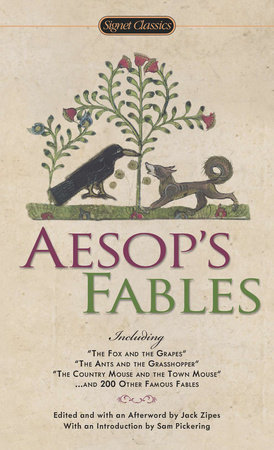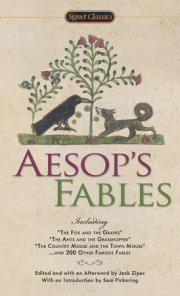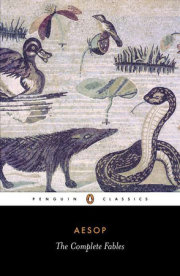Aesop, according to legend, was born either in Sardis, on the Greek island of Samos, or in Cotiaeum, the chief city in a province of Phrygia, and lived from about 620 to 560 B.C. Little is known about his life, but Aristotle mentioned his acting as a public defender, and Plutarch numbered him as one of the “Seven Wise Men.” It is generally believed he was a slave, freed by his master because of his wit and wisdom. As a free man, he went to Athens, ruled at that time by the tyrant Peisistratus, an enemy of free speech. As Aesop became famous for his fables, which used animals as a code to tell the truth about political injustice, he incurred the wrath of Peisistratus. Eventually, Aesop was condemned to death for sacrilege and thrown over a cliff. Later, the Athenians erected a statue in his honor. In about 300 B.C., Demetrius Phalereus of Athens made the first known collection of Aesop’s fables, which then spread far beyond the Greek world.
Jack Zipes is a professor of German at the University of Minnesota. He is the author of several books of fairy tales, including Breaking the Magic Spell and Don’t Bet on the Prince. He is also the editor of several volumes of fairy tales, including Beauties, Beasts and Enchantment: Classic French Fairy Tales, The Fairy Tales of Oscar Wilde, The Fairy Tales of Frank Stockton, and Arabian Nights.
Sam Pickering teaches English at the University of Connecticut. He has written seventeen books, fourteen of which are collections of essays. His most recent books are Waltzing the Magpies, an account of a year he and his family spent in Western Australia, and The Best of Pickering, both published by the University of Michigan Press.
A Note on the
Text and Illustrations
This edition of Aesop’s Fables is based on the Reverend Thomas James’s Aesop’s Fables: A New Version, Chiefly from Original Sources (New York: Robert B. Collins, 1848). While adapting this version of the fables, I consulted numerous other nineteenth-century translations and made various changes in keeping with the traditional plots. As has been the custom with translators and adapters of Aesop’s fables, I have taken a good deal of poetic license at times. Since Mr. James’s style is somewhat archaic, I have used a more modern American idiom in adapting them and have occasionally conceived new morals so that the fables might ring more “true” to the situation of the contemporary reader.
The illustrations are from Fables de La Fontaine illustrated by J.J. Grandville (Paris: H. Fournier, 1838). Grandville was a pseudonym for Jean Ignace Isidore Gérard (1803–1847). Born in Nancy, he arrived in Paris during the 1820s and soon made a name for himself as a lithographer and political caricaturist. He was especially interested the theater and animals and was known for incorporating political satire into his complex and fastidious drawings. During the 1830s he turned to book illustration and composed 120 woodcuts for La Fontaine’s fables, which were largely based on Aesop’s work; he caused quite a stir by turning many of the animals into types of human beings. In doing this, Grandville’s figures often appear grotesque and have a surreal quality to them. The distinction between beast and human is blurred, or rather, Grandville’s keen eye captures stunning similarities between humans and animals that often make humans appear in a ridiculous light. In addition, Grandville takes pains to give a clear indication of the social status of the figures through their clothing and behavior to comment on the French mores of his time. There are many emblematic references to urban life in Paris, and in this respect Grandville was one of the first artists to address modern problems of the city and industrialization. Grandville also illustrated the Fables de S. Lavalette (1841) and theFables de Florian (1842), two minor French fabulists, in the same unique manner and is considered one of the greatest interpreters of Aesop’s fables (through La Fontaine) for the modern age.
—J.Z.
Introduction
Little is known about Aesop, except that he lived in Greece, probably between 600 and 500 B.C. Happily for readers, scribblers can rarely resist adorning empty biographies with tales—appropriate in Aesop’s case, since generations have celebrated him as the archetypal storyteller. “What Aesop was by birth,” Nathaniel Crouch wrote in 1737, “authors don’t agree, but that he was of a mean condition, and his person deformed to the highest degree, is what all affirm: he was flat-nos’d, hunch-back’d, bloober-lip’d, jolt-headed: his body crooked all over, big-belly’d, badger-legg’d, and of a swarthy complexion. But the excellency and beauty of his mind made a sufficient atonement for the outward appearance of his person.” Add that he stuttered terribly, quite a handicap for a philosophic raconteur, and Aesop becomes a man delightful to discover on the page, no matter the quality of his mind.
Fictional accounts of Aesop’s life usually relate that he was sold as a slave in Ephesus. Later, in Samos, he behaved like Solomon, his wisdom reconciling the irreconcilable. After accusing magistrates at Delos of tomfoolery and corruption, however, he met a stony end. A gold cup pilfered from the shrine to the Oracle having been planted in his baggage, he was convicted of sacrilege and tossed “head-long from a high rock.” The moral being, I suppose, the wages of tale-telling will out.
In the literary underworld, lie and truth twine fruitfully together through generations, spawning page after page. Crouch lifted his life from the introduction of Roger L’Estrange’s famous collection of some five hundred fables published in 1692. In his collection published in 1722, Samuel Croxall took L’Estrange to task, declaring, “There were never so many blunders and childish dreams mixt up together, as are to be met with in the short compass of that piece.” Knowing “the little trifling circumstances” of Aesop’s life, Croxall said, was insignificant, “whether he was a slave or a freeman, whether handsome or ugly. He has left us a legacy in his writings that will preserve his memory clean and perpetual among us.”
Croxall also got matters wrong. Aesop told but did not write down fables. Much as The Thousand and One Nightsis a miscellany of stories drawn from diverse cultures stretching from Egypt to China, so the origins of Aesop’s fables are various, all editions being mongrel blends of tales taken from countries around the Mediterranean and to the east.
Copyright © 2014 by Aesop Aesop. All rights reserved. No part of this excerpt may be reproduced or reprinted without permission in writing from the publisher.









